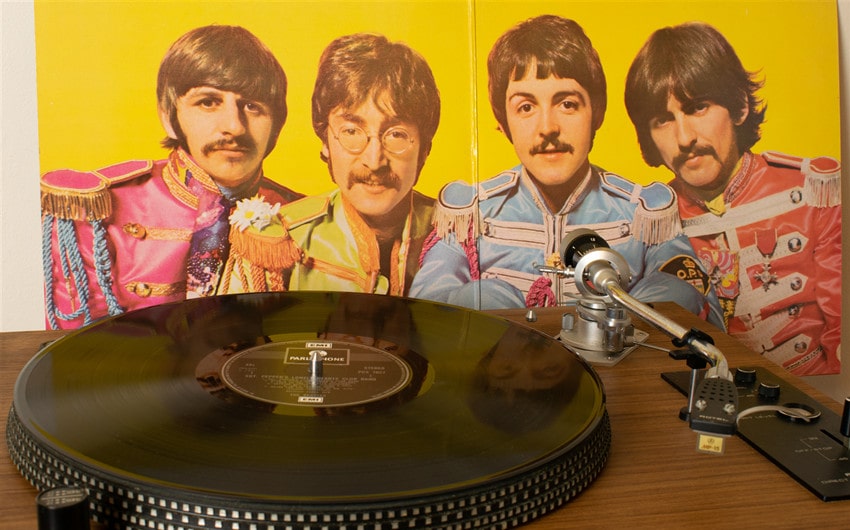Happiness Is a Warm Gun: Exploring The Beatles’ Darkest, Most Complex Metaphor
“Happiness Is a Warm Gun” stands out as one of the most haunting, provocative, and layered songs in The Beatles’ discography. Featured on their iconic 1968 “White Album,” this song merges stark social commentary, personal confessions, and raw, poetic imagery into a multi-part musical journey. From its jarring title to its chaotic structure, it demands that listeners engage with uncomfortable truths about desire, addiction, violence, and the fragile nature of human happiness. This article offers a deeply expanded exploration of the song’s meaning, origins, metaphorical layers, and its enduring cultural relevance today.
The Origins: John Lennon’s Dark Irony
John Lennon revealed that the title was inspired by a magazine advertisement from “American Rifleman” which boldly proclaimed, “Happiness is a warm gun in your hand.” This chilling phrase was meant to sell firearms by romanticizing the feeling of holding a recently fired gun. To Lennon, a vocal advocate for peace, the phrase struck a nerve—it was the epitome of irony. By adopting this slogan for the song, Lennon injected biting sarcasm into his critique of gun culture, violence, and society’s obsession with power and control.
In interviews, Lennon also admitted the song had deeply personal layers. His increasing heroin use during this period and his obsessive relationship with Yoko Ono are woven into the song’s fragmented lyrics, adding autobiographical weight to its metaphors. “Happiness Is a Warm Gun” became a paradoxical anthem about craving something that is simultaneously comforting and deadly—a theme that runs through many of Lennon’s personal struggles at the time.
The Musical Structure: A Chaotic Reflection of Inner Turmoil
Musically, “Happiness Is a Warm Gun” is one of The Beatles’ most experimental and structurally complex songs. It is divided into distinct, disjointed sections, each shifting in time signature, rhythm, and genre:
- The haunting intro: A slow, bluesy segment featuring surreal lyrics like “She’s not a girl who misses much,” which lulls the listener into a hypnotic state.
- The surreal middle: Rapidly shifts into aggressive, distorted guitar riffs accompanied by lyrics laced with dark humor and veiled references to addiction (“I need a fix ’cause I’m going down”).
- The doo-wop ending: Culminates in a twisted 1950s-style chant of the title phrase, layered with harmonies that create an eerie, almost cult-like feel.
This fragmented structure mirrors the emotional chaos of addiction, obsession, and the contradictory feelings that arise when pleasure is intertwined with harm. The sudden shifts in tone and pace disorient the listener, evoking the volatile highs and lows of desire, dependence, and self-destruction.
The Metaphor: Desire, Danger, and Addiction
On a metaphorical level, the “warm gun” operates as a stand-in for anything that offers an intense, immediate rush—whether it’s drugs, lust, or violence. For Lennon, the gun represented the allure of heroin and the obsessive desire for Yoko Ono, both of which provided comfort while simultaneously pulling him deeper into dependency and darkness.
Psychologically, the song explores the seductive pull of dangerous pleasures that promise happiness but deliver harm. The “warm gun” becomes a symbol of self-destruction disguised as comfort—a reflection of the human tendency to chase fleeting highs at the cost of long-term peace and well-being. This theme resonates broadly in areas like addiction recovery, where individuals grapple with the complex emotions of craving what they know is harmful.
Satire of Gun Culture and Power Fantasies
Beyond the personal, Lennon uses the song as a sharp satire of gun culture, particularly in America. By juxtaposing the word “happiness” with the violent imagery of a gun, the song critiques how weapons are marketed as tools of pleasure, empowerment, and masculinity. The doo-wop chant at the song’s conclusion, repeating the phrase like a deranged hymn, mocks the glorification of violence and the societal fantasy that power equals happiness.
This biting irony challenges listeners to examine the ways consumerism, nationalism, and toxic masculinity package violence as something desirable and fulfilling. Even decades later, the song remains a relevant commentary on how society still romanticizes weapons and aggression while ignoring the human cost of such fantasies.
Cultural Legacy and Modern Interpretations
“Happiness Is a Warm Gun” has sparked countless interpretations and debates among music critics, fans, and scholars. Some view it as a personal confessional of Lennon’s darkest impulses. Others see it as pure satire, while some interpret it as a broader exploration of the human fascination with power and pleasure.
Artists across genres have referenced or covered the song, drawn to its raw honesty and provocative metaphors. Its cultural legacy endures not only because of its controversial title but because it forces listeners to confront their own relationship with danger, desire, and happiness.
In today’s context, the song’s themes feel eerily relevant. In a world grappling with gun violence, addiction epidemics, and consumer-driven fantasies of happiness, Lennon’s message remains a mirror to uncomfortable truths about society and the human psyche.
Happiness, Danger, and the Human Condition
At its deepest level, “Happiness Is a Warm Gun” is a meditation on the human condition—the ways we crave intensity, connection, escape, and the lengths we’ll go to satisfy those cravings, even if they destroy us. The song doesn’t offer solutions or easy answers. Instead, it forces you to sit with the discomfort of knowing that what brings you comfort might also bring you harm.
It challenges you to question your own definitions of happiness. Is your happiness rooted in fleeting highs, external validation, or dangerous comforts? Or can it be found in more grounded, sustainable, and peaceful sources?
Conclusion: A Song That Still Haunts and Challenges
“Happiness Is a Warm Gun” is not an easy song—it’s unsettling, chaotic, and layered with disturbing beauty. But that’s exactly what makes it timeless. Lennon’s raw exploration of pleasure, pain, addiction, and violence remains a powerful artistic statement that dares you to look into the darker corners of your desires. By confronting these shadows, the song becomes more than just a critique of gun culture—it becomes a universal meditation on the complexity of human happiness and the ways it can turn deadly when entangled with obsession, escapism, and violence.






